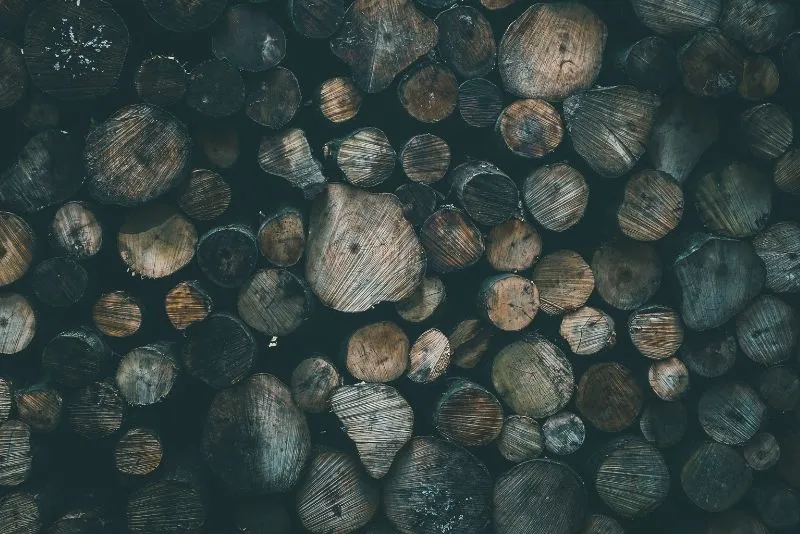It’s the time of year when many people are looking for ways to make their homes cozier and inviting, and sometimes that means a fire in the fireplace.
The first rule about burning firewood is to know what you’re burning.
Contents
Is Poplar Good Firewood
Poplar makes a wonderful firewood choice since it lights easily when dry and efficiently heats a home in the off-season. Poplar burns relatively quickly, making it a wonderful choice for campfires as most campers only want a fire to burn for a few hours.
If you’re thinking about adding poplar to your Woodstock, it’s important to know its pros and cons first.
Let’s get started by knowing more about poplar and whether or not you may use it as firewood.
Poplar Wood
The name “poplar” comes from the Latin word “Populus,” which means “people,” “nation,” or “state.” Poplar trees were known as the tree of the people because, under the Roman Empire, people would congregate around them for public gatherings.
The Poplar tree, a kind of tree that primarily thrives in temperate areas in the Northern Hemisphere, is the source of poplar wood. They are often short-lived trees that develop quite quickly. Aspens and cottonwoods are also varieties of poplar trees, in addition to the two widely popular varieties known as white poplars and white poplars.
They produce vastly softwood, which is used by numerous industries to create products including cardboard, paper, crates, and veneer. Aside from that, poplar trees are frequently used in landscaping as windbreaks or privacy screens because of how quickly they develop and are reputed to be aesthetically pleasing.
Can I Use Poplar As Firewood?
Technically, poplar wood can be used as firewood, but first, it needs to be treated. Because poplar wood burns down quickly once lighted, many people opt not to use it as firewood. It can burn quite hot, but it just doesn’t last. As a result, it is not advised to use poplar as firewood if you wish to heat your house overnight.
Poplar wood might be the best choice for you if all you’re looking for is a short, bright burn, though. Poplar is a softwood; therefore it burns for around two hours on average per log and is quite simple to light. Poplar firewood must first be treated before burning, though.
This is so that it may absorb a lot of moisture since poplar is a softwood. It usually doesn’t contain a lot of sap, which is a major factor in creosote buildup, but because of its moisture content, it needs to season for at least six months.
If you decide to utilize poplar logs as firewood, you will have to put a lot of work into preparing them.
To prevent them from getting wet and to allow for sufficient air circulation, these logs need to be split and hoisted off the ground. The logs can be raised to further delay decay.
Is Poplar Good Firewood?
Poplar is not good firewood and resembles softwood in certain ways. It burns well when thoroughly seasoned, like with most firewood, although you can become weary of constantly adding fuel. Because it burns quickly and you frequently go for additional firewood when using the stove, it is frequently referred to as “go-fer” firewood.
Despite the fact that many experts strongly oppose the use of poplar as firewood, there are a few benefits to it:
- Its accessibility and quick seasoning time are two main benefits. You can preserve your own supply of firewood because poplar trees are widely available in nature and can even be grown in your backyard.
- They also grow quickly, making it simple to take one down and produce another one in its place.
- Despite the fact that six months might seem like a long time, seasoning wood only takes a relatively short time.
- Six months is actually a pretty brief seasoning period because many species of wood require many months to thoroughly season. This implies that using your poplar logs won’t take long.
Poplar is a fantastic choice of firewood if you only intend to use your fire pit or log burner briefly because it won’t continue to burn for a long time after you are done with it.
Simply place a couple of longs in, let them burn, and they will extinguish. Because of this, you won’t have to worry about wasting fuel or waiting for it to completely go out.
Additionally, poplar is simple to light, requiring little in the way of firestarters.
Poplar Wood Splitting for Firewood:
Poplar is quite simple to deal with and splits like softwood. The log splits into pieces with only a single or a few swings, requiring little effort on your part. To increase the burn time, keep the pieces in the medium to large range. Poplar works better as kindling or beginning fuel than dense hardwood, thus kindling pieces can be cut to a smaller size.
Varieties Of Popular Tree Used As A Firewood
Although there are over 35 different species of poplar, the White Poplar, Eastern Poplar, Lombardy Poplar, or Balsam Poplar are the most abundant in the United States:
White Poplar Firewood
The enormous White Poplar can reach heights of more than 100 feet. Due to the white felted underside of its leaves, this tree is also known as the Silver Poplar. On young trees, the bark is smooth and greenish-white with distinctive diamond-shaped dark patterns; near the base of older trees, the bark turns black and is fissured.
Eastern Poplar Firewood
Another gigantic tree that can reach heights of over 100 feet is the eastern poplar. The eastern, central, and southern United States is where it is grown.
Lombardy Poplar Firewood
Simply observing the shape will allow you to recognize a Lombardy poplar. The Lombardy Poplar takes on the form of a pyramid as it grows.
Balsam Poplar Firewood
In the northern portion of the United States, swampland is where you’ll find balsam poplar. It stands out due to its fragrant, resinous buds.
Poplar Firewood’s Burning Capabilities
Poplar is great for campfires because it burns slowly. It will burn for 2 to 4 hours and leave behind a small amount of coal and a lot of ash. It gives off a quick burst of heat that doesn’t last long. When compared to other hardwoods, poplar burns rather easily. Pine is the closest match, and it is best used to start a fire.
It is used to make a lot of things, like matchsticks and fire starters. Also, it works best in the spring and fall, when the weather is not too hot or cold. It burns quickly and gives off a lot of heat in a short amount of time. Compared to other woods, poplar gives off very little heat per cord (volume).
Some hardwoods give off twice as much heat for the same amount of wood. It’s not something you should turn down for free, though. After all, the best firewood is free, easy to find, and plenty of.
It might smell bad when burned wet, but it doesn’t smell bad at all when the wood is completely dry. Wet firewood makes a lot of smoke and sparks, but dry firewood makes about the same amount of each.
| BTU: 13.7 per Cord (Million BTUs) |
| Dry Weight: 2080 lbs. per Cord |
| Splitting Difficulty: Low |
| Seasoning Time: 6-12 months |
| Sap Content: Low |
| Smoke: Moderate |
Poplar Firewood Seasoning Time
One of the best things about poplar is that it doesn’t need much time to dry out. Your poplar wood could be ready to burn in as little as six months. You can use green poplar as firewood, but it gives off a lot of smoke. About ten months is the best amount of time to let poplar dry out.
Poplar takes about a year to the season at most. Split the wood, stack it above the ground, and you’ll get the best results. If you don’t let enough air in, the wood will stay wet and green. Poplar will rot if you leave it on the ground for too long.
Poplar used as firewood should have less than 20% moisture, if possible. But this isn’t something that only poplars do. It’s true for all kinds of firewood.
Does Poplar wood produce Resin/Sap:
It is true that sap is produced by all trees. However, poplar trees don’t produce a lot of sap, making it simple to deal with. You won’t have sap all over when you split your wood.
What fragrance does Poplar have?
Although any sort of wood can be used as firewood, some types are preferable to others. You should look into the amount of heat produced in addition to the aroma of the wood. The majority of woods emit fruity, nutty, or piney scents.
Freshly cut poplar is reputed to have a distinctive aroma. Most likely, you’ll either love it or loathe it. While some claim it smells somewhat nice, others claim it reeks.
Is Poplar a clean-burning wood?
Poplar burns quickly and fiercely. It makes a mild quantity of smoke and sparks. If you only heat with Poplar on really cold days, you will have to keep adding wood to the stove to keep the fire going. Most of the time, Poplar has about half as many BTUs as Oak.
A lot of people use it for their summer fires when they don’t need a long fire or at the end of Spring when the weather is starting to warm up or at the beginning of Fall when the weather is starting to cool down. This type of wood is called “shoulder season.”
It doesn’t make a lot of coals, but it’s great for starting fires in harder woods like oak. However, it makes a fair amount of smoke and sparks, so if you’re burning Poplar firewood inside, keep your screen up.
Conclusion
So, is poplar a good choice for firewood? only if you prefer a quick, bright fire. Poplar is not frequently used as firewood since it burns quickly and is therefore terrible for heating indoor spaces.
Because poplar cannot burn for lengthy periods of time, many people believe that it is a poor choice for firewood.
Poplar, however, can be the best option if you only need firewood for a short period of time. There is certain to be someone out there whose preferred form of firewood is well-liked because everyone’s circumstances and tastes vary.

